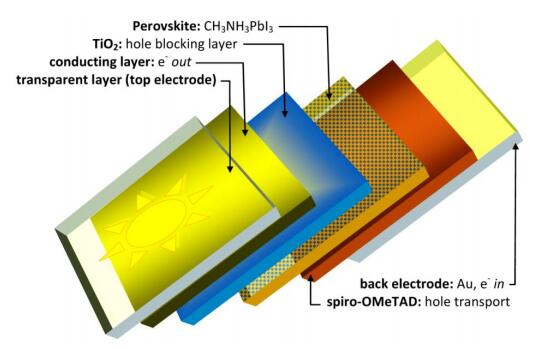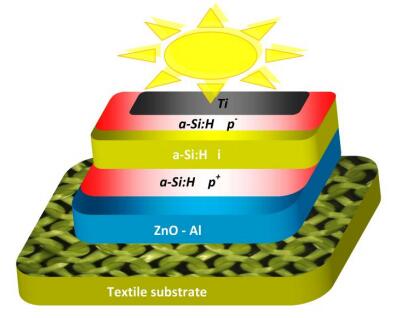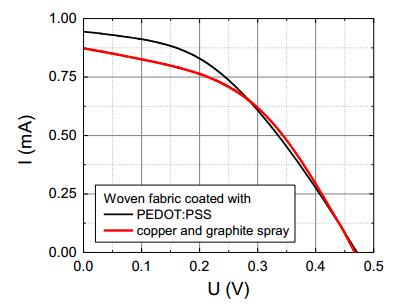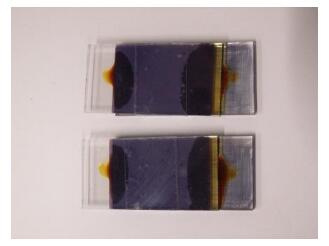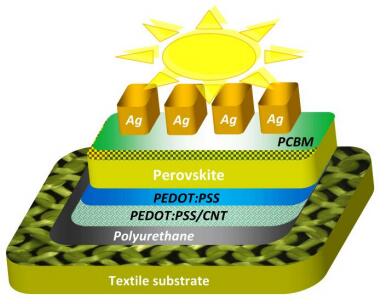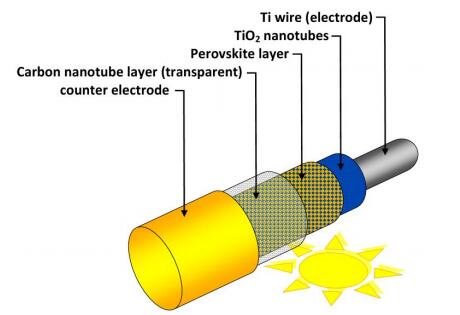Electronic textiles may be used to monitor a person’s vital function, to offer information or navigation, and to support people in daily life. One crucial problem, however, is the energy supply needed for such electronic functions. One of the possibilities discussed for this purpose is the integration of solar cells into garments. While silicon-based solar cells are mostly rigid or can in the meantime also be prepared in the shape of relatively flexible foils, the approach to integrate solar cell functionality into a textile fabric goes one step further. In this case, dye-sensitized solar cells (DSSCs), polymer or organic solar cells are advantageous. During the last years, promising advances are reported in the literature, discussing new materials for the different layers of such flexible solar cells. This review gives an overview of the recent materials used for creating flexible solar cells on textile fabrics or fibers.
1.
Introduction
For the creation of electronic textiles it is necessary to develop flexible, ideally foldable and breathable power sources such as batteries, super-capacitors and preferably also photovoltaics which could harvest energy instead of only storing it. There are, however, many challenges which have to be solved for this purpose. Solar cells based on amorphous silicon can be made flexible to a certain extent, but only with large bending radii which are not suited for integration in garments or other textile fabrics [1]. Generally, working on plastic substrates creates less flexible solar cells than it would be possible by using textile fabrics as substrates, making this path more promising for integration of solar cells into garments and other textile fabrics [2,3,4].
One of the alternative technologies is the dye-sensitized solar cell (DSSC) which was developed in 1991 [5]. DSSCs consist of two conductive electrodes, one of which is coated with a semiconductor, such as TiO2, ZnO or SnO2. This semiconductor is coated with a photoactive dye—besides a broad range of man-made dyes which are often expensive and/or toxic, also natural dyes can be used, usually resulting in relatively low efficiencies. The counter electrode is coated with a catalyst, often platinum or graphite. After both electrodes are contacted, the gap between them is filled with an electrolyte, typically based on iodine/triiodide or other redox couples, sometimes also containing metal salts [6].
DSSCs work as follows: A photon excites an electron of the dye which is injected into the conduction band of the semiconductor and afterwards moved into an external circuit with a load. Supported by the catalyst on the counter electrode, it enters the solar cell again where it reacts with the electrolyte, before the electrolyte reacts with the excited dye molecule, in this way closing the circle (Figure 1).
The other types of solar cells, those based on organic materials or the relatively recently invented perovskite solar cells, are generally based on planar technology. There is a real challenge to adopt such solutions into textile based devices. Nevertheless, it is worth mentioning that in classical solutions, organic solar cells are based on metallic electrodes and the active inner layer is made from the organic semiconducting material. For the perovskite cells the active layer is a perovskite structured organic-inorganic material. However, there are even alternatives to layered technology solutions based on single quantum dots [7]. The alternative solutions are presented at the end of this review.
Organic solar cells (OSCs), also described as polymer or organic small molecule solar cell [8], have the advantage in comparison to DSSCs that no (usually fluid) electrolyte is needed. Generally, the cell composition is nevertheless quite similar: The outer layers are again conductive electrodes. Between them, an electron transport layer can be found on the cathode, while a hole transport layer is applied on the anode. In this way, undesired charge recombination is reduced. Instead of the electrolyte, an active layer combining an electron donor and electron acceptor is embedded between electron and hole transport layers [9].
When a photon impinges on an OSC, excitons—electron-hole pairs—are created in the active layer and afterwards split into electrons and holes which are transported along the electron and hole transport layers, respectively, to the electrodes and an external circuit.
The next possibility to create flexible solar cells is based on perovskites. Perovskite solar cells (PSCs) reach large power conversion efficiencies [10] and enable processing at low temperatures which is important for applications on textile fabrics [11,12]. They are built nearly identical to OSCs, with the active layer now consisting from perovskites, i.e., materials with the crystal structure ABX3 (A = monovalent cation, B = metal cation, X = halide anion) [13]. One possible layered structure is depicted in Figure 2.
When a PSC absorbs a photon, an electron from the valence band of the perovskite is excited into the conduction band, leaving back a hole in the valence band. Both are transported through the electron and hole transport layers, respectively, to the electrodes and into an external circuit.
Finally it should be mentioned that some groups also investigated possibilities to transfer silicon based solar cells to textile fabrics. Ji et al., e.g., have just recently reported on conformal coating of different textile fabrics with amorphous silicon and germanium, using high-pressure CVD (chemical vapor deposition) [14]. They found relatively low efficiencies of 0.03% maximum, comparable to typical results of DSSCs prepared with natural dyes without optimization by nanostructures or the like [15]. A higher efficiency of up to 1.4% was gained by Plentz et al. who coated amorphous silicon thin-film solar cells on glass fiber fabrics with a thin semi-transparent titanium layer as top electrode, as depicted in Figure 3 [16]. These approaches, however, are not further described in this review.
The most important difference between common glass-based solar cells and solar cells applied on textile fabrics is naturally the substrate which differs in shape and most often also in material from the glass-based solutions. Besides fiber-based solar cells which will be described below, often woven or nonwoven textile fabrics are used, consisting of diverse materials. Liu et al., e.g., used glass fiber multilayer textile fabrics, in this way keeping the material and changing only the shape of the substrate which has the big advantage of enabling high-temperature processes, such as sintering of the semiconductor in dye-sensitized solar cells [17]. A completely different approach was chosen by Li et al. who worked on polyester/cotton woven fabrics and prepared all functional layers on top of this textile fabric by spray coating [18]. Similarly, Liang et al. used cotton clothes typically used for pregnant women to gain high comfort of the wearable electronics based on these textile fabrics [19]. Ji et al. compared both versions—on the one hand cotton, on the other hand carbon and stainless steel fiber fabrics—for high pressure chemical vapor deposition and found the stainless steel fabric to be well suited for solar fabrics [20].
Another important difference between textile-based and glass-based solar cells is related to their possible applications. Generally, textile-based solar cells are necessary for "smart" or, more exactly, electronic fabrics or wearable electronics, respectively, to power functions such as monitoring of vital signals, communication, etc. [17,19,21,22]. Other possible applications include unmanned aerial vehicles and space robots [23], military applications [24], textile architecture such as tents [25] and generally all stand-alone solutions in which the energy harvesting devices must be at least slightly foldable, bendable or even stretchable [26].
2.
Dye-sensitized solar cells
2.1. Dyes
One of the most important layers of DSSCs is the photo-active layer, i.e., the dye. Besides using natural or synthetic dyes, another interesting approach is decorating the surface of the semiconductor, i.e., mostly TiO2, by quantum dots. CdS and CdSe quantum dots, e.g., with band gaps of 2.42 eV and 1.84 eV, respectively, allow for a broader absorption wavelength range than pure N719 (one of the most often used dyes [27]) on TiO2 [28]. By using a certain distribution of quantum dot sizes and thus of correlated band gaps, multi-junction solar cells can be prepared [29]. Quantum dots can even generate more than one exciton if a photon of high enough energy is absorbed [30]. Recently, Grissom et al. suggested a new approach to use a carbon nanotube yarn as base for a DSSC, coated with a TiO2 photo-electrode which was treated with TiCl4 to prepare nanostructured TiO2 in the gaps of the microstructured first TiO2 layer and decorated with CdS and CdSe quantum dots. Using N719 as dye and a semi solid-state iodine-based electrolyte, they reached up to 7.6% conversion efficiency for this fiber-shaped DSSC [31].
Natural dyes are typically inexpensive and non-toxic, but show only small efficiencies [15]. TiO2 layers on glass during and after dyeing with hibiscus flower extract are depicted in Figure 4. An interesting natural dye reported by Sánchez-García et al. is carminic acid, a non-toxic dye prepared from cochineal insects which is known for centuries. Adsorbed on TiO2 which is coated on an FTO layer as active electrode, platinum as catalyst on the FTO back electrode and a iodine/triiodide based electrolyte, carminic acid resulted in an efficiency of 0.24% which was four times higher than measured in the identical cells prepared with carmine instead [32].
On flexible, but not textile substrates, PbS colloidal quantum dots were investigated which absorb in a broad spectral range from the UV to the IR [34,35,36], resulting in PbS solar cells with efficiencies of more than 11% [37]. Recently, a similar efficiency was reached in a PbS solar cell with optimized weight, flexibility and mechanical stability, using a spin-coated silver nanowire ink for the transparent front electrode, AlZnO as electron transport layer, two different PbS quantum dot layers, and finally a gold back electrode [38].
Generally, the dye is the most crucial parameter in dye-sensitized solar cells. While all layers, including the electrolyte, influence the DSSC performance severely, exchanging the dye can result in one or two orders of magnitude increase (or decrease) of the efficiency. Usually, this problem is solved by using toxic dyes, such as the well-known ruthenium-based dyes N719 or N3. For applications on textile fabrics, however, this solution is not applicable. Instead, there is a high demand to search for novel dyes which combine non-toxicity and high efficiency, starting either from the high-performance dyes and trying to make them less toxic, as in case of the ruthenium dye N712 which is based on the dye N3, but less toxic and at the same time less efficient and about one order of magnitude more expensive; or starting at non-toxic—typically natural—dyes, screening them systematically and developing them further by purification or blending them in the lab. As long as both approaches are not yet successful, achieving highly efficient textile-based DSSCs from non-toxic materials will stay a large challenge.
2.2. Semiconductor
Another crucial aspect is the semiconductor. In most applications on glass, TiO2 is sintered at temperatures from approx. 300 ℃–500 ℃ after coating. This process is usually necessary to retain the desired layer structure and to eliminate solvent residues, as visible in Figure 5, and is not possible on usual textile substrates.
Screen printed TiO2 layers were used by Liu et al. [39]. They screen printed an interface layer to smoothen the woven fabric surface firstly, followed by a screen printed silver paste and a TiO2 paste which was processed by only 150 ℃ to avoid degradation of the textile fabric. With a ruthenizer as dye, platinum as catalyst on the FTO coated glass counter electrode and a fluid iodine/triiodide based electrolyte, a conversion efficiency of up to 2.78% could be reached.
Liu et al. also reported on a low-temperature sintering process. Using the typical N719 dye and a platinum coated FTO glass as counter electrode, TiO2 nanoparticles were dissolved in water or tert-butanol, mixed with acetyl-acetone as stabilizer, partly mixed with Triton X100 as binder, and then screen printed or spray coated on the FTO coated front electrode. These films were sintered at 150 ℃ and 450 ℃, respectively. Interestingly, the cells prepared with water and without binder were found the best for both temperatures. Although efficiencies up to 4.3% could be reached by screen printing for the low-temperature sintering process, it should be mentioned that significantly higher values of up to 7.41% efficiency were reached by sintering at 450 ℃ [40].
On different textile substrates, especially a carbon woven fabric and a stainless steel nonwoven fabric, different minimum sintering temperatures for different TiO2 layers were found which was attributed to the textile surface structure [41,42].
Glass fiber fabrics were used to overcome the sintering problem by Opwis et al. [43]. After coating the fabric with titanium and titanium dioxide, the semiconductor was sintered at 500 ℃ and sensitized by diverse ruthenium-based dyes. A conductive foil was coated with Pt as catalyst to create the counter electrode. After the electrolyte was added, the whole cell was sealed. In this way, efficiencies around 1% were reached.
Yun et al. used stainless steel woven fabrics to enable sintering the TiO2 which was doctor bladed on them. Combined with N719 as the dye and activated carbon as well as platinum used as catalyst on the counter electrode, an efficiency of 4.16% was achieved [44].
ZnO thin films can also be prepared by pulsed laser deposition. Krämer et al. investigated the possibilities to coat ZnO on carbon fiber fabrics as well as single carbon fibers, the latter by applying a 3-step deposition process with the fiber being rotated between the steps [45]. Using N719 as sensitizer and a iodine/triiodide based electrolyte as well as a platinum wire as counter electrode and inserting the whole system into a fine glass capillary, an efficiency of 0.0019% could be reached.
An interesting approach was recently reported by Rezaei et al. [46]. They grew nanoflower-like TiO2, modified with Pt-C3N4 nanotubes, on glass and found the photocatalytic activity significantly enhances as compared to pure TiO2. This material was used in combined cells as the photo-anode of a DSSC and for photo-degradation of different dyes, reducing the degradation time by a factor of 2.
Nanofibrous Zn2SnO4 was used by Das et al. [47]. Using a precursor solution from zinc acetate, tin acetate and PMMA (poly(methyl methacrylate)), nanofibers were electrospun and afterwards calcinated to get ZnO-SnO2-Zn2SnO4 composite fibers or pure Zn2SnO4 fibers, depending on the calcination temperature. Using N719 as the sensitizer and FTO glasses as electrodes, maximum efficiencies of 1.93% were reached for the hollow Zn2SnO4 fibers.
Fan et al. created fiber-shaped DSSCs by using a stainless steel wire as active electrode and coating it with TiO2 nanoparticles. In this way, sintering at high temperatures was possible, before the residual layers were added [48].
Similarly, Pu et al. report on Ti wires dipcoated with TiO2 which were sintered at 450 ℃ before the TiO2 was sensitized with N719. A platinum wire surrounding the inner wire worked as counter electrode; the whole system was sealed in a transparent and flexible plastic tube which was filled with electrolyte. In this way, an average efficiency of 6% was reached [49].
A Ti wire was also used as the active electrode in fiber-shaped DSSCs prepared by Wen et al. [50]. TiO2 nanotubes were produce on this Ti wire and afterwards sintered at 500 ℃, post-treated with TiCl4 and then again sintered before dyed with N719. Platinum-coated carbon fibers were used as counter electrode. By placing both electrodes parallel in a tubing filled with iodine/triiodide based electrolyte, efficiencies up to 5.64% were reached.
Yang et al. grew titania nanotube arrays on a titanium wire which absorbed the dye [51]. Combined with graphene fibers on which platinum nanoparticles were electrochemically deposited as the counter electrode, a conversion efficiency of 8.45% was reached. Using a rotation-translation method, they wound aligned carbon nanotube sheets around rubber fibers, in this way producing elastic conductive fibers which enabled constructing stretchable fiber-shaped DSSCs with an efficiency of 7.13%.
Yun et al. prepared woven fabrics from glass fiber yarns and Ti wires, the latter serving as electrodes [52]. The counter electrode wires were electroplated before platinum electrodeposition. The TiO2 paste was coated on the whole textile fabric, sintered at 480 ℃—which is possible with glass, as opposed to more common textile materials—and afterwards sensitized with N719. The cell was completely sealed before an acetonitrile-based electrolyte was injected through a hole. In this way, efficiencies up to 0.6% could be reached, depending on the warp and weft spacing.
While photo-electrode and counter electrode were parallel in the previous paper, Chai et al. used weft and warp threads of a woven fabric for active and counter electrodes, respectively [53]. Mn-coated polymer monofilaments were coated with ZnO nanowires which were afterwards sensitized by N719. CuI serves as the surrounding solid electrolyte. As counter electrode, a polymer monofilament or a cotton yarn is coated with Cu. In this way, efficiencies around 0.7% were gained, independent from the number of bending cycles performed before.
A very similar structure was proposed by Chen et al. who tested different weaving patterns and found a size of 20 cm2 sufficient to deliver an output of 0.5 mW under a solar intensity of 80 mW/cm2 [54].
Another fiber-based solution was suggested by Weintraub et al. [55]. They coated an optical fiber with ITO as the active electrode and grew ZnO nanowires on this optical fiber before the DSSC was completed with the other layers.
2.3. Catalyst and counter electrode
Another aspect of DSSC integration into textile fabrics which has to be taken into account is the catalyst. While the simplest way to add a catalyst on a conductive glass is using a graphite pencil, this technique does no longer work on textile fabrics. This is why typical textile finishing methods such as spraying graphite solutions onto the counter electrodes and coating with graphite dispersions were compared, finding that an optimized spraying process could significantly increase the power conversion efficiency [56]. In Figure 6 a comparison between the current–voltage characteristics of two different woven counter electrodes, coated with PEDOT:PSS or with copper and graphite spray, is depicted.
Mengal et al. prepared a highly conductive woven electrode by coating with a graphite composite decorated with activated charcoal [58]. Combined with a quasi-solid electrolyte prepared with polyethylene oxide, very low charge transfer resistance and high electro-catalytic activity were found, resulting in a power conversion efficiency of 7.09%.
Similarly, Memon et al. used a composite from acid-functionalized multiwall carbon nanotubes and mesoporous activated charcoal to create highly conductive, photocatalytically active counter electrodes on cotton, polyester and linen fabrics [59]. In combination with a gel electrolyte, photovoltaic conversion efficiencies of 5.80% (on linen) up to 6.26% (on polyester) were reached.
A graphene-coated cotton fabric was also used as counter electrode by Sahito et al. [60]. This composite was found to be stable against bending and washing with water. Combined with a polymer electrolyte, an efficiency of 6.93% was achieved. Using activated charcoal doped multiwall carbon nanotubes as catalyst and N719 as dye, even 7.29% efficiency could be reached [61].
A polyaniline (PANi) coating on a carbon fabric was investigated by Motlagh and Mottaghitalab. They compared different polymerization methods and found that electro-polymerization resulted in highest conductivity, porosity and molecular structure, even in comparison to platinum, and finally a power conversion efficiency of 3.81% [62].
Working with natural dyes, Juhász Junger et al. investigated the influence of electrospun polyacrylonitrile nanofiber mats coated with PEDOT:PSS as nanostructured counter electrodes in half-textile DSSCs [63,64]. They found that by tailoring the number of PEDOT:PSS layers on the counter electrode, the efficiency could be optimized. A slight further increase was visible after HCl treatment of the conductive layers.
Xu et al. prepared a counter electrode by coating a cotton fabric with nickel and afterwards with polypyrrole as catalyst. Combined with a iodine/triiodide based electrolyte, a power conversion efficiency of 3.83% could be reached [65].
2.4. Electrolyte
Finally, the electrolyte is a big problem. Usually being fluid, as visible in Figure 7, it tends to evaporating through an open-pore textile. One possibility to avoid this problem is refilling it, either in the form of the original electrolyte or by water, e.g., by rain in the case of an outdoor solar textile. By refilling DSSCs with electrolyte, the power reduction with time could be stopped for min. four months for some of the natural dyes under investigation, while refilling with water did not have this effect [66].
Sahito et al. suggested another approach to overcome this problem [67]. They used electrospinning to prepare poly(vinylidene fluoride) nanofiber mats which were filled with a iodine/triiodide electrolyte and served as separator between both electrodes and matrix stabilizing the electrolyte. By adding LiCl salt, the ionic conductivity and the charge transfer resistance could be improved, resulting in an increased efficiency of 8.73% which was only 1.9% lower than in identical cells with purely fluid electrolyte.
Another solution based on a textile matrix was suggested by Sun et al. [68]. They used a polyethylene terephthalate (PET) wet-laid nonwoven as a matrix to absorb the electrolyte and at the same time as a spacer to avoid short-circuits, resulting in an efficiency of more than 10% and a longer lifetime of the DSSC as compared to similar systems with a pure fluid electrolyte.
As a last point it should be mentioned that the reproducibility is a challenge when working on textile-based DSSCs. Even for glass-based DSSCs, large deviations of the efficiencies of nominally identical cells can occur which can be attributed, e.g., to the graphite layer and the pressure by which the glass plates are pushed together, defining the amount of electrolyte between them [69].
3.
Organic solar cells
3.1. Two-dimensional solar cells
Organic solar cells are less often reported to be integrated into textile fabrics. Based on polypropylene nonwovens, OSCs were built using combinations of evaporation and spin-coating [70,71,72,73], resulting in an efficiency of 0.2%.
The surface of a woven fabric first coated with a polyethylene buffer layer to create a smoother surface before the OSC was built on it [74]. Sufficient adhesion of the first OSC electrode on the polyethylene was gained by a plasma treatment of the buffer layer, before the OSC was built by screen printing and evaporation. No stable efficiencies could be reported due to electric short circuits.
With spray-coated electrodes on a polyester/cotton woven fabric, Arumugam et al. reached 0.02% efficiency, which is significantly lower than the 2.7% gained on glass with otherwise identical materials, but still shows that this technique may be promising [75,76].
Based on a woven fabric coated by polymer-assisted metal deposition, a wet transfer method was used to transfer the active layer and the top electrode on this conductive fabric. In this way, power conversion efficiencies similar to those on rigid substrates could be reached [77].
3.2. Fibrous (one-dimensional) solar cells
On the other hand, organic solar cells were produced in the shape of fibers and afterwards woven into textile fabrics [78,79,80], by this reducing the original efficiency due to shading the active threads in the fabric.
Sugino et al. [81] used a stainless steel wire as primary electrode which was coated by ZnO as electron transport layer. The active layer P3HT:PCBM (Poly(3-hexylthiophene): [6,6]-phenyl-C61-butyric acid methyl ester) was followed by PEDOT:PSS as a transparent electrode which was wrapped by a gold wire as secondary electrode. Finally, the fibers were coated with acrylate resin dispersion for sealing and afterwards woven into a PET fabric. In this way, efficiencies up to 4.6% were reached.
The same active layer was used by Ebner et al. who prepared organic solar cells based on viscose fibers dipcoated with a silver nanowire suspension [82]. Using PEDOT:PSS as a hole conductor and a thin outer aluminum electrode, they reached efficiencies around 5%.
With the identical active layer, Wu et al. created solar textiles on transparent electronic fabrics [83]. A polyester/silver nanowire/graphene core-shell structure was blade-coated with PEDOT:PSS before the active layer was blade-coated. LiF and aluminum layers were thermally evaporated as the cathode. In this way, a power conversion efficiency of 2.27% could be reached.
Thinking about fiber-shaped electrodes, the problem arises to connect all these electrodes. Liu et al. [84] reported a possible solution for this problem. They designed a large woven structure, using warp and weft orientation for cathode and anode fibers and enabling at the same time the creation of an electrically conductive circuit by the weaving pattern. These polymer solar cells survived the weaving process and showed high flexibility, making them useful for electronic textiles.
Usually, textile-based solar cells cannot be washed. Jinno et al. demonstrated the principle possibility to create even washable organic solar cells by coating the cell from both sides with an elastomer which protects the active part of the cell from water. While an efficiency of 7.9% was reached before washing, only a small decrease of this value was found after immersion in water for two hours [85].
4.
Perovskite solar cells
Jung et al. recently reported on flexible PSCs on textile substrates [86]. Building a PSC on a polyurethane coating on a woven fabric, efficiencies up to 5.72% could be achieved. Here, PEDOT:PSS (poly(3, 4-ethylenedioxythiophene):polystyrene sulfonate) doped with single-walled carbon nanotubes was used as anode. A low-conductive PEDOT:PSS layer was coated on top of the anode before the perovskite layer, consisting of CH3NH3PbI3 was added. PCBM (phenyl-C61-butyric acid methyl ester) was used as electron transport layer before a microstructured silver cathode was placed on top. This setup is depicted in Figure 8.
Another approach to create flexible perovskite solar cells was reported by Ma et al. [87]. Using hole-transporting polyaniline, solvothermally processed halides and an electron-transporting PDBM layer with a three-dimensional gel matrix, conversion efficiencies between 3.62% in an undeformed state and 5.57% in a compressed state were gained.
Combining a perovskite solar cell with SnO2 electron transport layer and a second thin PCBM electron transport layer and encapsulating the whole solar cell with an elastomer can be used to create flexible textile-based perovskite solar cells [88]. In this way, an efficiency of 15% could be reached for an even washable solar cell.
A fiber-shaped perovskite solar cell was produced by Wang et al. [89]. They used a Ti wire on which TiO2 nanotubes were formed by anodization in an electrolyte containing fluoride. The intermediate compact TiO2 layer which is also formed during the anodization process works as blocking layer. The following perovskite layer is added by dip-coating before a semi-transparent flexible film of carbon nanotubes is wrapped around the whole wire. In this system, conversion efficiencies of 1.16% were achieved. One possible setup of a fiber-shaped perovskite solar cell is depicted in Figure 9.
Another approach to create highly foldable perovskite solar cells is by using cellulose in the shape of paper instead of typical fiber-based structures. Here, Li et al. just recently reached the highest conversion efficiency of paper-based perovskite solar cells with a value of more than 13% [90], while Castro-Hermosa et al. prepared the first perovskite solar cell directly on paper earlier and already found good power conversion efficiencies up to 2.7% [91]. These experiments also offer new possibilities for textile-based perovskite solar cells.
5.
Conclusion
While DSSCs are the type of solar cells most often used in textile-based applications, organic or even perovskite as well as a few silicon-based solutions are reported in the literature. Each of them have their challenges, related to the foldability and sometimes even stretchability of a textile fabric, the problem that textile solar cells cannot be sealed without losing their textile haptics and thus liquid electrolytes cannot be used, and finally the washability which would be necessary for integration in garments and which is nearly never addressed. On the other hand, textile-based solar cells suggest large advantages since they could be integrated not only into garments but also into large-scale textile architecture, overcoming the problem of the usually relatively small power conversion efficiencies when nontoxic, inexpensive materials are used.
This review gives an overview of the most recent findings and approaches to solve the still existing problems and may serve to support researchers in these fields as a base for their own projects.
Acknowledgements
The work was partially supported by the SUT Rector grant 14/990/RGJ18/0099 (T. B.).
Conflict of interest
All authors declare no conflicts of interest in this paper.
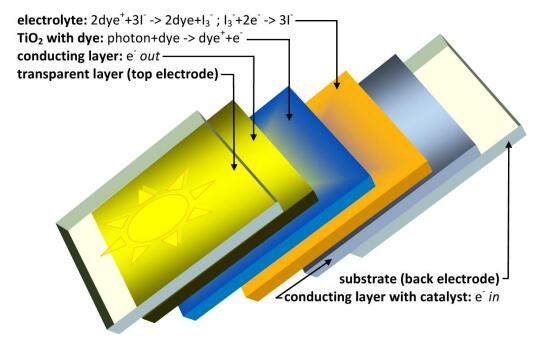









 DownLoad:
DownLoad:











